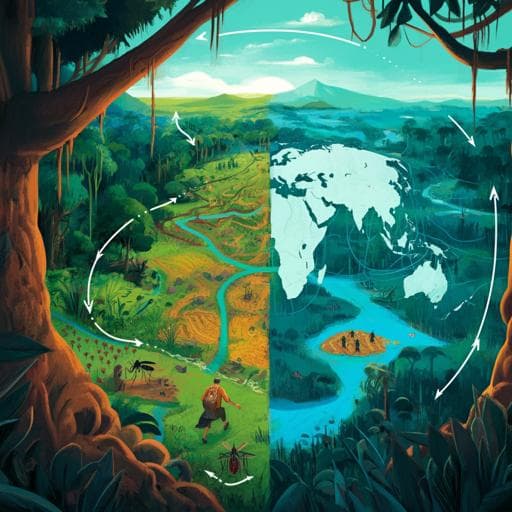
Environmental Studies and Forestry
Global consumption and international trade in deforestation-associated commodities could influence malaria risk
L. S. M. Chaves, J. Fry, et al.
This groundbreaking study reveals how global commodity consumption, which drives deforestation, increases malaria risk in developing countries. Conducted by a team of experts including Leonardo Suveges Moreira Chaves and others, it highlights the interconnectedness of trade and tropical health, advocating for demand-side policies to combat both malaria and deforestation.
~3 min • Beginner • English
Introduction
The study investigates how global consumption and international trade in commodities associated with deforestation influence malaria risk in tropical, malaria-endemic regions. Building on established evidence that deforestation alters vector ecology and increases malaria transmission, the authors hypothesize that demand in high-income countries for export-oriented commodities (e.g., timber, cocoa, coffee, tobacco, cotton) drives deforestation in low-income, malaria-prone countries, thereby elevating malaria risk. The aims are to quantify links between export-oriented production and forest exploitation, reveal trade-network connections between consumers and producers in malaria-prone countries, and identify countries facing significant malaria risk attributable to global consumption and trade.
Literature Review
The paper synthesizes extensive evidence linking deforestation to increased malaria incidence and vector abundance across major tropical rainforest biomes (Amazon, Congo Basin, Greater Mekong). Cited studies show: in Indonesia, a 1 SD decline in forest cover increases outbreak likelihood by ~10 percentage points; in Nigeria, forest loss is associated with increased malaria in children under five; in the Amazon, a 10% increase in forest cleared leads to a 3.3% rise in malaria incidence and malaria burden can reduce forest clearing; small-scale deforestation patches correlate with higher incidence; in Brazilian Amazon contexts, percent land deforested strongly predicts incidence. Entomological studies across East Africa, Southeast Asia, and tropical America show deforestation increases larval habitat temperature, reduces development times, enhances adult survivorship, shifts Anopheline community composition toward efficient vectors (e.g., Nyssorhynchus darlingi, Ny. nuneztovari), and reduces biodiversity that otherwise suppresses vector populations. The review establishes a consistent pattern: anthropogenic forest disturbance increases vector-human contact opportunities and malaria risk. It also notes that demand for primary commodities (timber, soybean, beef, palm oil, tobacco, cocoa, coffee, cotton) drives forest exploitation linked to malaria risk.
Methodology
Overall approach: The study quantifies a malaria footprint that links deforestation-associated malaria risk in producer countries to global consumption via multi-regional input–output (MRIO) analysis using Leontief’s method. It constructs a satellite account of malaria risk mapped to deforestation-implicated commodities and couples this with the Eora MRIO database to track risk through international supply chains to final consumers.
Malaria risk definition and regression: Malaria risk is defined as the number of potential cases in the presence of deforestation but in the absence of public health interventions. Using country-level time series (2000–2015), actual malaria incidences I_r(t) are regressed against (a) cumulative tree cover loss L_r(t), (b) coverage of insecticide-treated nets π(t), and (c) coverage of artemisinin-based combination therapies α(t): Σ_r I_r(t) = β0 + β1 Σ_r L_r(t) + β2 π(t) + β3 α(t). A weighted multiple regression (weights for 2001, 2005, 2014) achieves R^2 ≈ 0.91, yielding significant coefficients: β0 ≈ 170.0×10^6 cases (99%), β1 ≈ 0.31×10^6 cases per million hectares cumulative tree cover loss (99%), β2 ≈ −282×10^6 cases per % ITN (99%), β3 ≈ −143×10^5 cases per % ACT (95%). Setting π(t)=α(t)=0 yields overall malaria risk in the presence of deforestation but without interventions. The portion attributable to deforestation is obtained by subtracting actual incidences from overall risk; country shares are apportioned by each country’s share of actual incidence.
Commodity allocation (satellite account): Country-wise malaria risk totals are allocated across deforestation-implicated commodities using FAOSTAT land-use change data (soybeans, oil palm fruit, cattle, sheep, buffalo, timber, wood products, tobacco, cocoa, coffee, cotton). For crops, annual land-use change (hectares) is used; for livestock, animal head counts are converted to land-use via stocking rates. This allocation maps to corresponding sectors in each MRIO country.
MRIO and footprint computation: Using the Eora MRIO transactions (T), final demand (Y), and outputs (x), the Leontief inverse L=(I−A)^−1 with A=T x̂^−1 is computed. A malaria footprint tensor F^r_st = q^r_i L^{rs}_{ij} y^t_j is evaluated, where q^r_i are sectoral malaria risk intensities in producer country r, L describes transformation through supply chains, and y^t_j denotes final demand by households in country t. High-performance computation evaluates all supply-chain paths. Footprints can be aggregated to bilateral footprints F^r_t, and net malaria risk trade is defined as exports minus imports (F^r_+ − F^r_−).
Data sources: Malaria incidence from WHO; tree cover loss from Global Forest Change; intervention coverage from MAP; commodity and land-use data from FAOSTAT; MRIO from Eora. Uncertainty in MRIO-based results is typically ~10%.
Key Findings
- Approximately 20% of malaria risk in global deforestation hotspots is associated with international trade in deforestation-implicated export commodities (timber, cocoa, coffee, tobacco, cotton, wood products). The remaining ~80% is linked to domestic, deforestation-related activities (e.g., firewood collection, subsistence agriculture).
- In 2015, an estimated 110 million additional people were at risk of contracting malaria due to deforestation, alongside ~135 million recorded malaria cases globally.
- About 10% of global deforestation-linked malaria risk is connected to just ten net-importing countries, exacerbating risk for approximately 10.7 million people in low-income, mostly African exporter countries.
- Country-specific risk (2015): Nigeria (~5.98 million deforestation-linked risk cases) tied to exports of timber to China (~$332m), cocoa beans to the Netherlands (~$334m), Germany (~$72m), Belgium/France/Spain/Italy (~$35m total), and charcoal to Europe (~$35m). Tanzania (~5.66m) linked to exports of raw tobacco (~$344m to Europe/Asia; $96m to Belgium), raw cotton (~$41m to South and Southeast Asia), and sawn wood to India (~$20m). Uganda (~5.49m) associated with coffee exports to Italy (~$88m), Germany (~$63m), Belgium (~$40m), USA and Spain (~$21m each), and raw cotton (~$15m). Cameroon (~5.49m) linked to cocoa exports to the Netherlands (~$300m) and to Spain/Belgium/France/Germany (~$79m), rough wood to China (~$175m), and sawn timber (~$440m) to multiple destinations.
- Major primary trade routes originate in tropical Africa, India, and Myanmar (raw cocoa, tea, coffee, tobacco, timber), proceeding to processing hubs in China, Japan, and Western Europe, and then to final consumers across the Americas, Europe, Russia, China, Japan, Southeast Asia, Australia, and New Zealand. Historical colonial links are prominent in primary trade routes between European nations and former African colonies.
- Per-capita consumer footprints (risk cases per 1000 inhabitants, 2015): Netherlands/Belgium (~31.25), Switzerland/Germany (~22.3; cocoa and tobacco), UK (~17.85; tea), France/Spain/Italy (~13.39; cocoa and coffee), Japan (~8.92; wood products), USA (~4.46; various products).
- From 2000 to 2015, international trade in rough logs, sawn wood, raw cocoa, coffee, tea, tobacco, and cotton increased, coinciding with continued deforestation (cumulative losses >10,000 km² in Nigeria, Uganda, Cameroon, India; >100,000 km² in DR Congo and Indonesia). Importing developed countries often increased domestic forest cover while outsourcing forest-intensive production.
- Beef and palm oil do not appear among top malaria-linked trade flows because key exporters (e.g., Brazil, Malaysia) have relatively low malaria incidence.
Discussion
Findings substantiate that demand in high-income countries for commodities linked to deforestation contributes measurably to malaria risk in low-income, malaria-endemic producer countries. The global value chain is unequal: low-value commodity producers bear ecological degradation and health burdens, while value added accrues in wealthy consumer markets. Current malaria control funding, largely from high-income donors, remains insufficient relative to needs; addressing upstream demand drivers can complement interventions and reduce long-term dependence on control measures. The study argues for demand-side policies integrated along supply chains: consumer engagement and certification (deforestation- and malaria-safe products), proactive supplier governance (procurement standards, transparency), government/NGO support (training, legality verification, monitoring), and fiscal instruments or royalty mechanisms to reduce overexploitation while protecting smallholder livelihoods. Aligning with existing deforestation-focused initiatives (e.g., cocoa supply chain commitments, Soy Moratorium, zero-deforestation agreements) can generate co-benefits for biodiversity, climate, and public health. Overall, linking malaria risk to consumption highlights transboundary responsibilities and provides actionable levers beyond traditional vector control.
Conclusion
The study introduces a quantitative framework that links deforestation-driven malaria risk to global consumption via MRIO supply-chain analysis. It shows that roughly one-fifth of malaria risk in deforestation hotspots is trade-driven, identifies key commodities and trade routes, and estimates that 110 million people were at additional risk in 2015 due to deforestation. By attributing risk to final consumers, the work supports demand-side policy measures to complement ITN/ACT interventions and align with deforestation-reduction initiatives. Future research could refine risk attribution with higher-resolution spatial and sectoral data, incorporate additional cofactors (e.g., climate variability, migration) explicitly, evaluate the effectiveness of certification and governance interventions on health outcomes, and extend analysis beyond 2015 to assess evolving trade patterns and intervention coverage.
Limitations
- The malaria risk metric is a counterfactual synthetic measure (cases in presence of deforestation without interventions), relying on regression assumptions; other cofactors (e.g., climate, migration) are captured in the intercept rather than modeled explicitly.
- The multiple regression employs a linear form with weighting for select years; while fit is high (R^2 ≈ 0.91), alternative functional forms may capture nuances not reflected here.
- Allocation of malaria risk to commodities uses FAOSTAT land-use proxies and livestock stocking rate estimates; sectoral mapping may introduce allocation uncertainty.
- MRIO data (Eora) carry measurement errors and uncertainties (~10% typical for aggregate footprints); results depend on sectoral/temporal resolution and concordance of datasets.
- The analysis period (2000–2015) limits inference on recent changes in trade, interventions, and deforestation; some commodities (e.g., beef, palm oil) may be underrepresented in top links due to low-incidence exporters, not necessarily low deforestation impact.
- Country-level aggregation may mask subnational heterogeneity in deforestation–malaria dynamics and supply-chain linkages.
Related Publications
Explore these studies to deepen your understanding of the subject.







